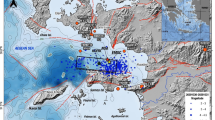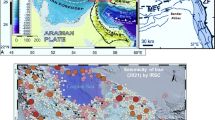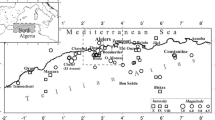Abstract
On 30 October 2020, an Mw 6.9 normal faulting earthquake to the north and offshore from the island of Samos, very close to the south west coast of Turkey, occurred at 14:51 local time (11:51:34.8 UTC). In this study, the stress change features of the rupture process and the co-seismic surface deformation of the island of Samos during this event are analyzed. The co-seismic slip distribution model of the causative fault was initially adopted, inverted from the Global Centroid Moment Tensor (GCMT) solution for the Mw 6.9 Samos 2020 earthquake. Then, this GCMT-inverted fault source model (uniform-slip) was used to compute the co-seismic Coulomb stress changes in the crustal volume affected by the early seismicity and to analyze the Coulomb stress change characteristics of the mainshock in terms of early aftershocks, stress state of the causative fault, and of the adjacent Samos island. Lastly, interferometric synthetic aperture radar (InSAR) interferograms (Sentinel-1 satellites) were used to measure the co-seismic surface displacements of the adjacent island of Samos and to evaluate stress transfer of the causative fault. Finally, the results obtained from the Coulomb stress changes associated with the co-seismic slip distribution and InSAR observations were compared. The Coulomb stress change features caused by the uniform-slip for the causative fault were in good agreement with the pattern of aftershock distributions in the first week following the mainshock. It was found that most of the aftershocks occurred in end-fault and off-fault lobes, as areas of Coulomb stress increase of 2–5 bar, and in the stress shadow zone near the rupture, as an area of Coulomb stress decreases of between − 4 and − 5 bar, corresponding to the largest slip patch (~ 2.7 m) according to the uniform-slip. A rupture propagation direction from E (~ 2.7 m max. slip) to W (~ 30 cm min. slip) and asymmetric deepening of the slip distribution down to a depth > 10 km in the fault plane, in agreement with our uniform-slip model, explained the Samos mainshock, Coulomb stress changes, and co-seismic deformation of Samos island. The best constraints on the early deformation pattern of Samos island, in the absence of near-mainshock seismic stations, obtained from InSAR data revealed maximum displacement (± ~ 10 cm) of the island from E to W and from SE (subsidence) to NW (uplift). Finally, based on the Coulomb stress change and InSAR computation, it is concluded that the 2020 Samos mainshock increased the stress level of the assumed faults and/or possible fault segments in the N and adjacent to Samos island in the S as a result of end-fault and off-fault lobes.








Similar content being viewed by others
References
AFAD (2020) www.afad.gov.tr. Accessed 2020
Aktug B, Nocquet JM, Cingöz A, Parsons B, Erkan Y, England P, Lenk O, Gürdal MA, Kilicoglu A, Akdeniz H, Tekgül A (2009) Deformation of western Turkey from a combination of permanent and campaign GPS data: limits to block-like behavior. J Geophys Res Solid Earth 114
Altunel E, Pınar A (2020) Tectonic implications of the Mw 6.8, 30 October 2020 Kuşadası Gulf earthquake in the frame of active faults of Western Turkey. Turkish Journal of Earth Sciences.https://doi.org/10.3906/yer-2011-6
Becker D, Meier T, Rische M, Bohnhoff M, Harjes HP (2006) Spatio-temporal microseismicity clustering in the Cretan region. Tectonophysics 423:3–16
Benetatos C, Kiratzi A, Papazachos C, Karakaisis G (2004) Focal mechanisms of shallow and intermediate depth earthquakes along the Hellenic Arc. J Geodyn 37:253–296
Biryol BC, Beck SL, Zandt G, Özacar AA (2011) Segmented African lithosphere beneath the Anatolian region inferred from teleseismic P-wave tomography. Geophys J Int 184:1037–1057
Bohnhoff M, Harjes HP, Meier T (2005) Deformation and stress regimes in the Hellenic subduction zone from focal mechanisms. J Seismol 9:341–366
Chen CW, Zebker HA (2001) Two-dimensional phase unwrapping with use of statistical models for cost functions in nonlinear optimization. Josa A 18(2):338–351. https://doi.org/10.1364/JOSAA.18.000338
Collettini C, Sibson RH (2001) Normal faults, normal friction? Geology 29:927–930
De Boorder H, Spakman W, White SH, Wortel MJR (1998) Late Cenozoic mineralization, orogenic collapse and slab detachment in the European Alpine Belt. Earth Planet Sci Lett 164:569–575
Doğan, B., Irmak, T.S., Karakaş, A. and Kalafat, D., 2016. Seismotectonic content by the source parameters of the 10 June 2012 Ölüdeniz-Fethiye (Dodecanese Islands) Mw 6.1 earthquake and aftershocks (SW-Turkey). Acta Geodaetica et Geophysica, 51(1), pp.15–41.
Dogan GG, Yalciner AC, Yuksel Y, Ulutaş E, Polat O, Güler I, Şahin C, Tarih A, Kânoğlu U (2021) The 30 October 2020 Aegean Sea tsunami: post-event field survey along Turkish coast. Pure and applied geophysics, 1–28. Advance online publication. https://doi.org/10.1007/s00024-021-02693-3
Drakatos G, Latoussakis J (2001) A catalog of aftershock sequences in Greece (1971–1997): Their spatial and temporal characteristics. J Seismol 5:137–145
Dziewonski AM, Maternovskaya NN (2000) Centroid-moment tensor solutions for October-December 1999. Phys Earth Planet Inter 121:205–221
Dziewonski AM, Chou TA, Woodhouse JH (1981) Determination of earthquake source parameters from waveform data for studies of global and regional seismicity. J Geophys Res 86:2825–2852
Evelpidou N, Karkani A, Kampolis I (2021) Relative sea level changes and morphotectonic implications triggered by the Samos earthquake of 30th October 2020. J Mar Sci Eng 9:40. https://doi.org/10.3390/jmse9010040
Faccenna C, Becker TW, Auer L, Billi A, Boschi L, Brun JP, Capitanio FA, Funiciello F, Horvàth F, Jolivet L, Piromallo C, Royden L, Rossetti F, Serpelloni E (2014) Mantle dynamics in the Mediterranean. Rev Geophys 52:283–332
Floyd MA, Billiris H, Paradissis D, Veis G, Avallone A, Briole P, McClusky S, Nocquet JM, Palamartchouk K, Parsons B, England PC (2010) A new velocity field for Greece: implications for the kinematics and dynamics of the Aegean. J Geophys Res Solid Earth 115:B10403
Foumelis M, Papazachos C, Papadimitriou E, Karakostas V, Ampatzidis D, Moschopoulos G, Kostoglou A, Ilieva M, Minos-Minopoulos D, Mouratidis A, Kkallas C, Chatzipetros A (2021) On rapid multidisciplinary response aspects for Samos 2020, M 7.0 earthquake. Acta Geophys 69:1025–1048. https://doi.org/10.1007/s11600-021-00578-6
Freed AM (2005) Earthquake triggering by static, dynamic, and postseismic stress transfer. Annu Rev Earth Planet Sci 33–335
Friederich W, Brüstle A, Küperkoch L, Meier T, Lamara S (2014) Focal mechanisms in the southern Aegean from temporary seismic networks—implications for the regional stress field and ongoing deformation processes. Solid Earth 5:275–297
GCMT (2020) https://www.globalcmt.org/CMTsearch.html. Accessed 2020
Goldstein RM, Werner CL (1998) Radar interferogram filtering for geophysical applications. Geophys Res Lett 25(21):4035–4038. https://doi.org/10.1029/1998GL900033
Gomberg J, Reasenberg PA, Bodin P, Harris RA (2001) Earthquake triggering by seismic waves following the Landers and Hector mine earthquakes. Nature 411:462–466
Govers R, Wortel MJR (2005) Lithosphere tearing at STEP faults: response to edges of subduction zones. Earth Planet Sci Lett 236:505–523
Harris RA, Simpson RW (1998) Suppression of large earthquakes by stress shadows: a comparison of coulomb and rate-and-state failure. J Geophys Res 103:24439–24451
Harris RA, Simpson RW, Reasenberg PA (1995) Influence of static stress changes on earthquake locations in southern California. Nature 375:221–224
Hatzfeld D, Besnard M, Makropoulos K, Hatzidimitriou P (1993) Microearthquake seismicity and fault-plane solutions in the southern Aegean and its geodynanic implications. Geophys J Int 115:799–818
Hollenstein C, Geiger A, Kahle HG, Veis G (2006) CGPS time-series and trajectories of crustal motion along the West Hellenic Arc. Geophys J Int 164:182–191
Hollenstein C, Müller MD, Geiger A, Kahle HG (2008) Crustal motion and deformation in Greece from a decade of GPS measurements, 1993–2003. Tectonophysics 449:17–40
Irmak TS (2013) Focal mechanisms of small-moderate earthquakes in Denizli Graben (SW Turkey). Earth Planet Space 65:943–955. https://doi.org/10.5047/eps.2013.05.011
Irmak TS, Doğan B, Yavuz E, Livaoglu H, Sertcelik F (2020) Focal mechanisms of the January 22, 2020 Akhisar-Manisa earthquake (Mw 5.5) and its aftershocks: seismotectonic implications. Turk J Earthq Res 2(1):27–46
Irmak TS, Taymaz T (2009) Source mechanics of recent moderate earthquakes occurred in Honaz-Denizli (W-Turkey) graben obtained by regional broadband waveform inversion. In International Symposium on Historical Earthquakes and Conservation of Monuments in the Eastern Mediterranean Region, Istanbul, Turkey, 350–356 pp.
Irmak TS (2020) Finite fault source model of the 2020 Samos earthquake. https://twitter.com/TSirmak/status/1323029790790701056. Accessed 2020
Jackson JA, White NJ (1989) Normal faulting in the upper continental crust: observations from regions of active extension. J Struct Geol 11:15–36
Jolivet L, Faccenna C, Huet B, Labrousse L, Le Pourhiet L, Lacombe O, Lecomte E, Burov E, Denèle Y, Brun JP, Philippon M, Paul A, Salaün G, Karabulut H, Piromallo C, Monié P, Gueydan F, Okay AI, Oberhänsli R, Pourteau A, Augier R, Gadenne L, Driussi O (2013) Aegean tectonics: strain localisation, slab tearing and trench retreat. Tectonophysics 597–598:1–33
Jost ML, Knabenbauer O, Cheng J, Harjes HP (2002) Fault plane solutions of microearthquakes and small events in the Hellenic arc. Tectonophysics 356:87–114
Kahle H-G, Cocard M, Peter Y, Geiger A, Reilinger R, Barka A, Veis G (2000) GPS-derived strain rate field within the boundary zones of the Eurasian, African, and Arabian Plates. J Geophys Res 105:23353–23370. https://doi.org/10.1029/2000JB900238
King G, Stein S, Lin J (1995) Static stress changes and the triggering of earthquakes. Int. J. Rock Mech. Min. Sci. Geomech. Abstr. 32 (2):A50–A51. https://doi.org/10.1016/0148-9062(95)94484-2.
Kiratzi A, Louvari E (2003) Focal mechanisms of shallow earthquakes in the Aegean Sea and the surrounding lands determined by waveform modelling: a new database. J Geodyn 36:251–274
Kiratzi A, Benetatos C, Roumelioti Z (2007) Distributed earthquake focal mechanisms in the Aegean Sea. Bull Geol Soc Greece 40:1125–1137
KOERI (2020) http://www.koeri.boun.edu.tr/sismo/2/30-ekim-2020-mw6-9-ege-denizi-izmir-depremi/. Accessed 2020
Ma J, Dong L, Zhao G, Li X (2018) Discrimination of seismic sources in an underground mine using full waveform inversion. Int J Rock Mech Min Sci 106:213–222
Ma J, Dong L, Zhao G, Li X (2019) Focal mechanism of mining-induced seismicity in fault zones: a case study of yongshaba mine in China. Rock Mech Rock Eng 52(9):3341–3352
McClusky S, Balassanian A, Barka A, Demir C, Ergintav S, Georgiev I, Gurkan O, Hamburger M (2000) Global positioning system constraints on plate kinematics and dynamics in the eastern Mediterranean and Caucasus. J Geophys Res 105:5695–5719
METU Report (2020) Field observation of structural and seismic damage of the 30 October 2020 Mw 6.6 Samos island (off coast Izmir-Seferihisar) earthquake, 2020. Middle East Technical University (METU) Earthquake Engineering Research Center (EERC), Report No: ODTÜ/DMAM 2020–03 November, Ankara, https://eerc.metu.edu.tr/tr/system/files/documents/Izmir-Seferihisar%20Deprem%20Raporu.pdf.
Mora O, Ordoqui P, Iglesias R, Blanco P (2016) Earthquake rapid mapping using ascending and descending Sentinel-1 TOPSAR interferograms. Procedia Computer Science 100:1135–1140. https://doi.org/10.1016/j.procs.2016.09.266
Nomikou P, Evangelidis D, Papanikolaou D, Lampridou D, Litsas D, Tsaparas Y, Koliopanos I (2021) Morphotectonic analysis along the northern margin of Samos Island, related to the seismic activity of October 2020, Aegean Sea. Greece Geosciences 11(2):102. https://doi.org/10.3390/geosciences11020102
Papazachos B, Comninakis P, Scordilis E, Karakaisis G, Papazachos C (2009) A catalogue of earthquakes in the Mediterranean and surrounding area for the period 1901 – Sept 2009. Publ. Geophys, Laboratory, University of Thessaloniki
Parsons T, Yeats RS, Yagi Y, Hussain A (2006) Static stress change from the 8 October, 2005 M07.6 Kashmir earthquake. Geophys Res Lett 33.https://doi.org/10.1029/2005GL025429
Pe-Piper G, Piper DJW (2006) Unique features of the Cenozoic igneous rocks of Greece, in: Dilek, Y., Pavlides, S. (Eds.), Postcollisional tectonics and magmatism in the Mediterranean region and Asia. Geological Society of America, pp. 259–282.
Piromallo C, Morelli A (2003) P wave tomography of the mantle under the Alpine-Mediterranean area. J Geophys Res Solid Earth 108
Pondrelli S, Morelli A, Ekström G, Mazza S, Boschi E, Dziewonski AM (2002) European-Mediterranean regional centroid-moment tensors; 1997–2000. Phys Earth Planet Int 130:71–101
Pondrelli S, Morelli A, Ekström G (2004) European-Mediterranean regional centroid-moment tensor catalog; solutions for the years 2001 and 2002. Phys Earth Planet Int 163:96–113
Reasenberg PA, Simpson RW (1992) Response of regional seismicity to the static stress change produced by the Loma Prieta earthquake. Science 255:1687–1690
Reilinger R, McClusky S, Vernant P, Lawrence S, Ergintav S et al (2006) GPS constraints on continental deformation in the Africa–Arabia–Eurasia continental collision zone and implications for the dynamics of plate interactions. J Geophys Res 111:B05411. https://doi.org/10.1029/2005JB004051
Reilinger R, McClusky S, Paradissis D, Ergintav S, Vernant P (2010) Geodetic constraints on the tectonic evolution of the Aegean region and strain accumulation along the Hellenic subduction zone. Tectonophysics 488:22–30
Rontogianni S, Konstantinou KI, Melis NS, Evangelidis CP (2011) Slab stress field in the Hellenic subduction zone as inferred from intermediate-depth earthquakes. Earth, Planets Sp 63:139–144
Ryan WBF, Carbotte SM, Coplan JO, O’Hara S, Melkonian A, Arko R, Weissel RA, Ferrini V, Goodwillie A, Nitsche F, Bonczkowski J, Zemsky R (2009) Global multi-resolution topography synthesis. Geochemistry, Geophys. Geosystems 10
Šílený J, Horálek J (2016) Shear-tensile crack as a tool for reliable estimates of the non-double-couple mechanism: West Bohemia-Vogtland earthquake 1997 swarm. Physics and Chemistry of the Earth, Parts a/b/c 95:113–124
Tan O, Papadimitriou EE, Pabucçu Z, Karakostas V, Yörük A, Leptokaropoulos K (2014) A detailed analysis of microseismicity in Samos and Kusadasi (Eastern Aegean Sea) areas. Acta Geophys 62(6):1283–1309. https://doi.org/10.2478/s11600-013-0194-1
Thatcher W, Hill DP (1991) Fault orientations in extensional and conjugate strike-slip environments and their implications. Geology 19:1116–1120
Toda S, Stein RS, Richards-Dinger K, Bozkurt SB (2005) Forecasting the evolution of seismicity in southern California: animations built on earthquake stress transfer. J Geophys Res 110(B5), B05S16. https://doi.org/10.1029/2004JB003415. http://earthquake.usgs.gov/research/software/coulomb. Accessed 2020
Toker M (2021) Symptomatic discretization of small earthquake clusters reveals seismic coupling to 2017 Bodrum earthquake (Mw 6.6) in the Gulf of Gökova (SW corner of Turkey): viscous-compliant seismogenesis over back-arc setting. J Afr Earth Sci 177:104156. https://doi.org/10.1016/j.jafrearsci.2021.104156
Triantafyllou I, Gogou M, Mavroulis S, Lekkas E, Papadopoulos GA, Thravalos M (2021) The tsunami caused by the 30 October 2020 Samos (Aegean Sea) Mw7.0 earthquake: hydrodynamic features, source properties and impact assessment from post-event field survey and video records. J Mar Sci Eng 9:68. https://doi.org/10.3390/jmse9010068
Utkucu M, Durmus H, Nalbant S (2017) Stress history controls the spatial pattern of aftershocks: case studies from strike-slip earthquakes. Int J Earth Sci 106:1841–1861
Utkucu M, Nalbant SS, Pınar A, McCloskey J, Nicbhloscaidh M, Turhan F, Yalçın H, Kızılbuğa S, Coşkun Z, Ertan EK, Gülen L (2021) The June 12, 2017 Mw 6.3 Karaburun-Lesvos earthquake of the Northern Aegean Sea: aftershock forecasting and stress transfer. Tectonophysics 814:228945. https://doi.org/10.1016/j.tecto.2021.228945
van Hinsbergen DJJ, Kaymakci N, Spakman W, Torsvik TH (2010) Reconciling the geological history of western Turkey with plate circuits and mantle tomography. Earth Planet Sci Lett 297:674–686
Vavryčuk V, Adamová P (2020) Non-double-couple moment tensors of earthquakes calculated using empirical Green’s functions. Seismol Res Lett 91(1):390–398
Vavryčuk V (2011) Tensile earthquakes: theory, modeling, and inversion. Journal of Geophysical Research: Solid Earth, 116(B12)
Veci L, Lu J, Prats-Iraola P, Scheiber R, Collard F, Fomferra N, Engdahl M (2014) The Sentinel-1 Toolbox In Proceedings of the IEEE International Geoscience and Remote Sensing Symposium (IGARSS), pp. 1–3. IEEE
Wang R, Gu YJ, Schultz R, Chen Y (2018) Faults and non-double-couple components for induced earthquakes. Geophys Res Lett 45(17):8966–8975
Wessel P, Smith WHF (1998) New, improved version of the Generic Mapping Tools released. Eos 79:579
Zoback ML (1992) First- and second-order patterns of stress in the lithosphere: the World Stress Map Project. J Geophys Res 97(B8):11703–11728. https://doi.org/10.1029/92JB00132
Zoback ML, Zoback M, Adams J, Assumpção M, Bell S, Bergman EA, Blümling P, Brereton NR, Denham D, Ding J, Fuchs K, Gay N, Gregersen S, Gupta HK, Gvishiani A, Jacob K, Klein R, Knoll P, Magee M, Mercier JL, Müller BC, Paquin C, Rajendran K, Stephansson O, Suarez G, Suter M, Udías A, Xu ZH, Zhizhin M (1989) Global patterns of tectonic stress. Nature 341:291–298. https://doi.org/10.1038/341291a0
Acknowledgements
We send our greatest thanks to Dr. Huseyin Tur (Istanbul University-Cerrahpaşa, Geophysical Engineering, Istanbul) for his recommendations on co-seismic surface displacements of Samos island, interpretation of InSAR results, and for InSAR discussions about the submarine rupture source of the earthquake and to Dr. T. Serkan Irmak (Kocaeli University, Geophysical Engineering, Kocaeli) for his excellent waveform fittings and subfault CMT solutions on co-seismic slip distribution model of Samos island and for discussions about various model patterns of slip distribution performed by him. The authors are grateful to the Research and Service Support team of the European Space Agency (ESA) for SAR images. The authors are also grateful to Mr. Jeremy Jones, of the Academic Writing Department of Kocaeli University, Izmit, Turkey, for his assistance in editing the English used and for his help and advice concerning the contents of this manuscript. We sincerely thank the reviewers and the editor. The original manuscript was improved by detailed reviews from the two anonymous reviewers and the editor. Their thoughtful and critical comments helped greatly to shape the final form of this manuscript. We used the Coulomb 3.3 Software developed by USGS (Toda et al. 2005) and the GMT software package to plot some of the maps (Wessel and Smith 1998).
Author information
Authors and Affiliations
Corresponding author
Ethics declarations
Conflict of interest
The authors declare that they have no competing interests.
Additional information
Responsible Editor: Longjun Dong
Rights and permissions
About this article
Cite this article
Toker, M., Şentürk, E. & Bayık, Ç. Early preliminary results on co-seismic deformation of the island of Samos associated with co-seismic slip following the October 2020 Mw 6.9 Samos earthquake (Greece). Arab J Geosci 14, 2691 (2021). https://doi.org/10.1007/s12517-021-08951-x
Received:
Accepted:
Published:
DOI: https://doi.org/10.1007/s12517-021-08951-x




